Monopolistic Competition in Australia: A Case Study of Gloria Jean's Coffee
VerifiedAdded on 2023/04/21
|7
|1321
|103
AI Summary
This essay provides an insight on the firm that has monopolistic power operating in Australia, focusing on Gloria Jean's Coffee. It discusses the characteristics of monopolistic competition, the inefficiencies in outcome, and government intervention to curb power.
Contribute Materials
Your contribution can guide someone’s learning journey. Share your
documents today.
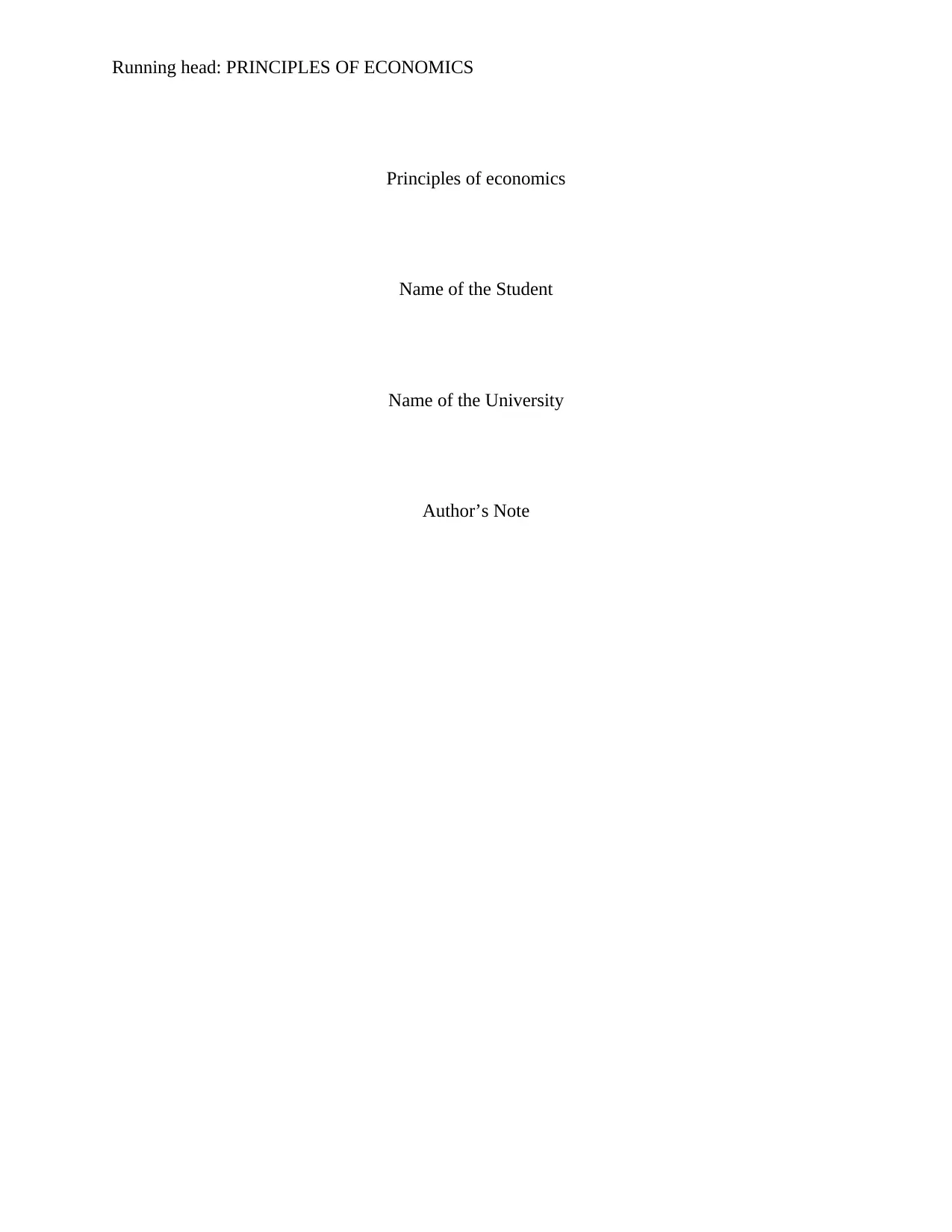
Running head: PRINCIPLES OF ECONOMICS
Principles of economics
Name of the Student
Name of the University
Author’s Note
Principles of economics
Name of the Student
Name of the University
Author’s Note
Secure Best Marks with AI Grader
Need help grading? Try our AI Grader for instant feedback on your assignments.
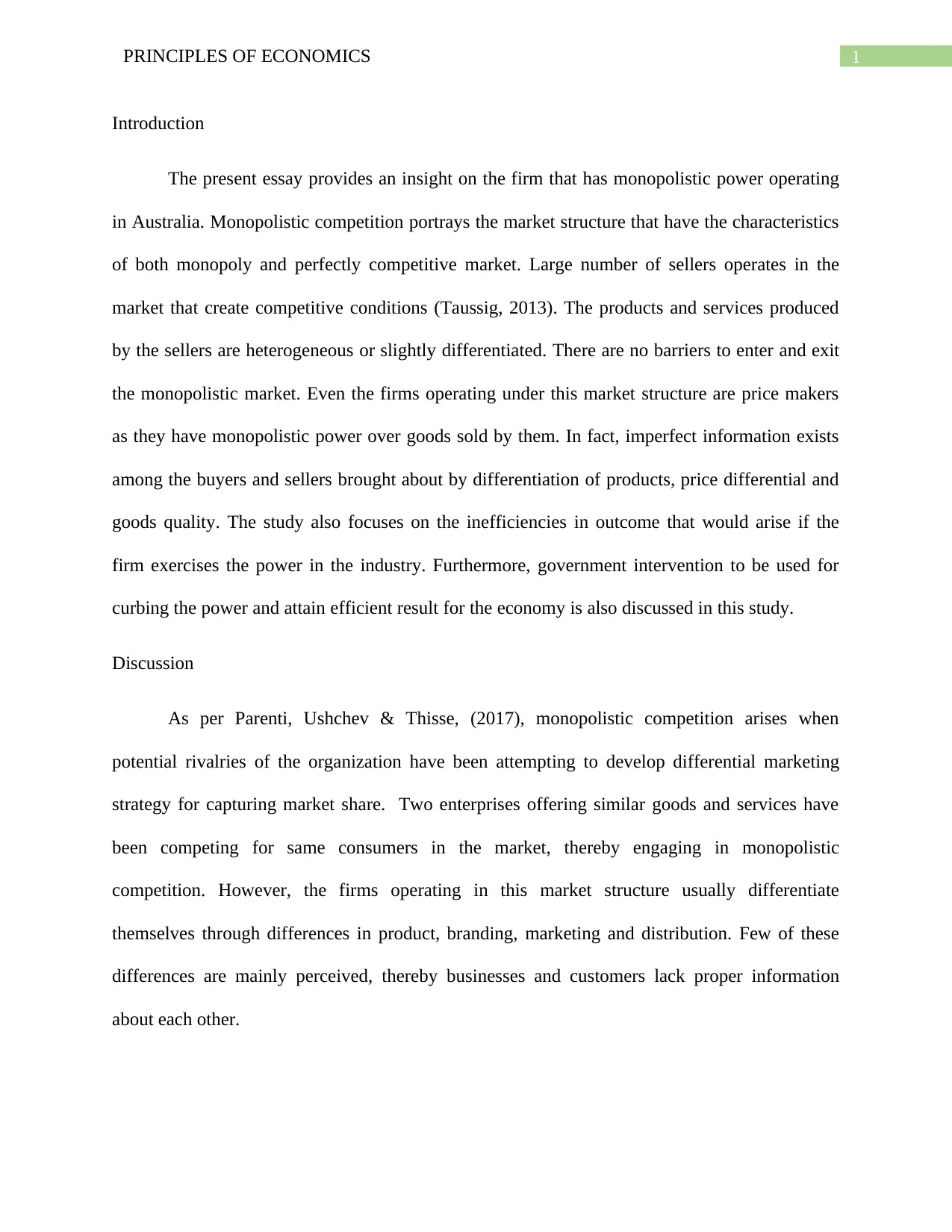
1PRINCIPLES OF ECONOMICS
Introduction
The present essay provides an insight on the firm that has monopolistic power operating
in Australia. Monopolistic competition portrays the market structure that have the characteristics
of both monopoly and perfectly competitive market. Large number of sellers operates in the
market that create competitive conditions (Taussig, 2013). The products and services produced
by the sellers are heterogeneous or slightly differentiated. There are no barriers to enter and exit
the monopolistic market. Even the firms operating under this market structure are price makers
as they have monopolistic power over goods sold by them. In fact, imperfect information exists
among the buyers and sellers brought about by differentiation of products, price differential and
goods quality. The study also focuses on the inefficiencies in outcome that would arise if the
firm exercises the power in the industry. Furthermore, government intervention to be used for
curbing the power and attain efficient result for the economy is also discussed in this study.
Discussion
As per Parenti, Ushchev & Thisse, (2017), monopolistic competition arises when
potential rivalries of the organization have been attempting to develop differential marketing
strategy for capturing market share. Two enterprises offering similar goods and services have
been competing for same consumers in the market, thereby engaging in monopolistic
competition. However, the firms operating in this market structure usually differentiate
themselves through differences in product, branding, marketing and distribution. Few of these
differences are mainly perceived, thereby businesses and customers lack proper information
about each other.
Introduction
The present essay provides an insight on the firm that has monopolistic power operating
in Australia. Monopolistic competition portrays the market structure that have the characteristics
of both monopoly and perfectly competitive market. Large number of sellers operates in the
market that create competitive conditions (Taussig, 2013). The products and services produced
by the sellers are heterogeneous or slightly differentiated. There are no barriers to enter and exit
the monopolistic market. Even the firms operating under this market structure are price makers
as they have monopolistic power over goods sold by them. In fact, imperfect information exists
among the buyers and sellers brought about by differentiation of products, price differential and
goods quality. The study also focuses on the inefficiencies in outcome that would arise if the
firm exercises the power in the industry. Furthermore, government intervention to be used for
curbing the power and attain efficient result for the economy is also discussed in this study.
Discussion
As per Parenti, Ushchev & Thisse, (2017), monopolistic competition arises when
potential rivalries of the organization have been attempting to develop differential marketing
strategy for capturing market share. Two enterprises offering similar goods and services have
been competing for same consumers in the market, thereby engaging in monopolistic
competition. However, the firms operating in this market structure usually differentiate
themselves through differences in product, branding, marketing and distribution. Few of these
differences are mainly perceived, thereby businesses and customers lack proper information
about each other.
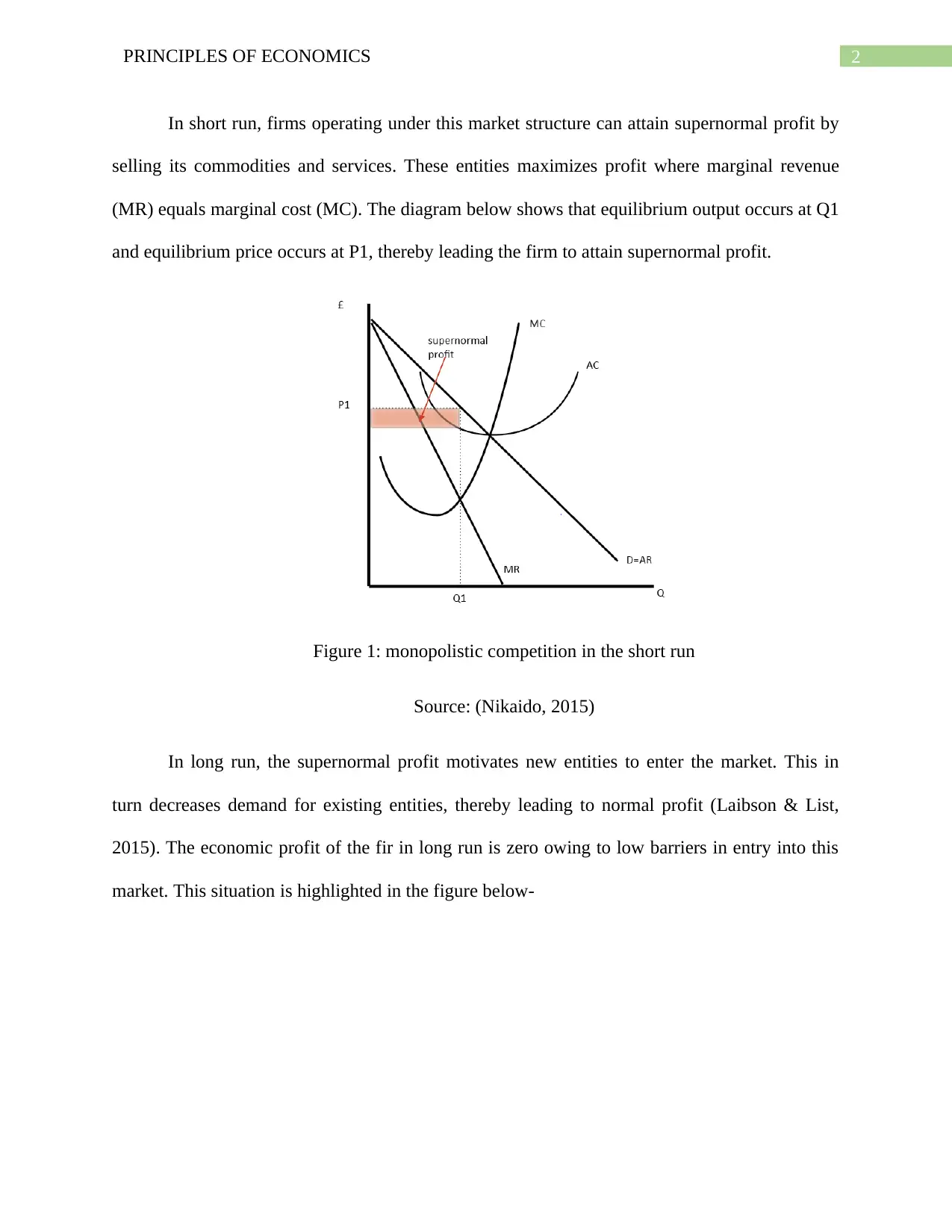
2PRINCIPLES OF ECONOMICS
In short run, firms operating under this market structure can attain supernormal profit by
selling its commodities and services. These entities maximizes profit where marginal revenue
(MR) equals marginal cost (MC). The diagram below shows that equilibrium output occurs at Q1
and equilibrium price occurs at P1, thereby leading the firm to attain supernormal profit.
Figure 1: monopolistic competition in the short run
Source: (Nikaido, 2015)
In long run, the supernormal profit motivates new entities to enter the market. This in
turn decreases demand for existing entities, thereby leading to normal profit (Laibson & List,
2015). The economic profit of the fir in long run is zero owing to low barriers in entry into this
market. This situation is highlighted in the figure below-
In short run, firms operating under this market structure can attain supernormal profit by
selling its commodities and services. These entities maximizes profit where marginal revenue
(MR) equals marginal cost (MC). The diagram below shows that equilibrium output occurs at Q1
and equilibrium price occurs at P1, thereby leading the firm to attain supernormal profit.
Figure 1: monopolistic competition in the short run
Source: (Nikaido, 2015)
In long run, the supernormal profit motivates new entities to enter the market. This in
turn decreases demand for existing entities, thereby leading to normal profit (Laibson & List,
2015). The economic profit of the fir in long run is zero owing to low barriers in entry into this
market. This situation is highlighted in the figure below-
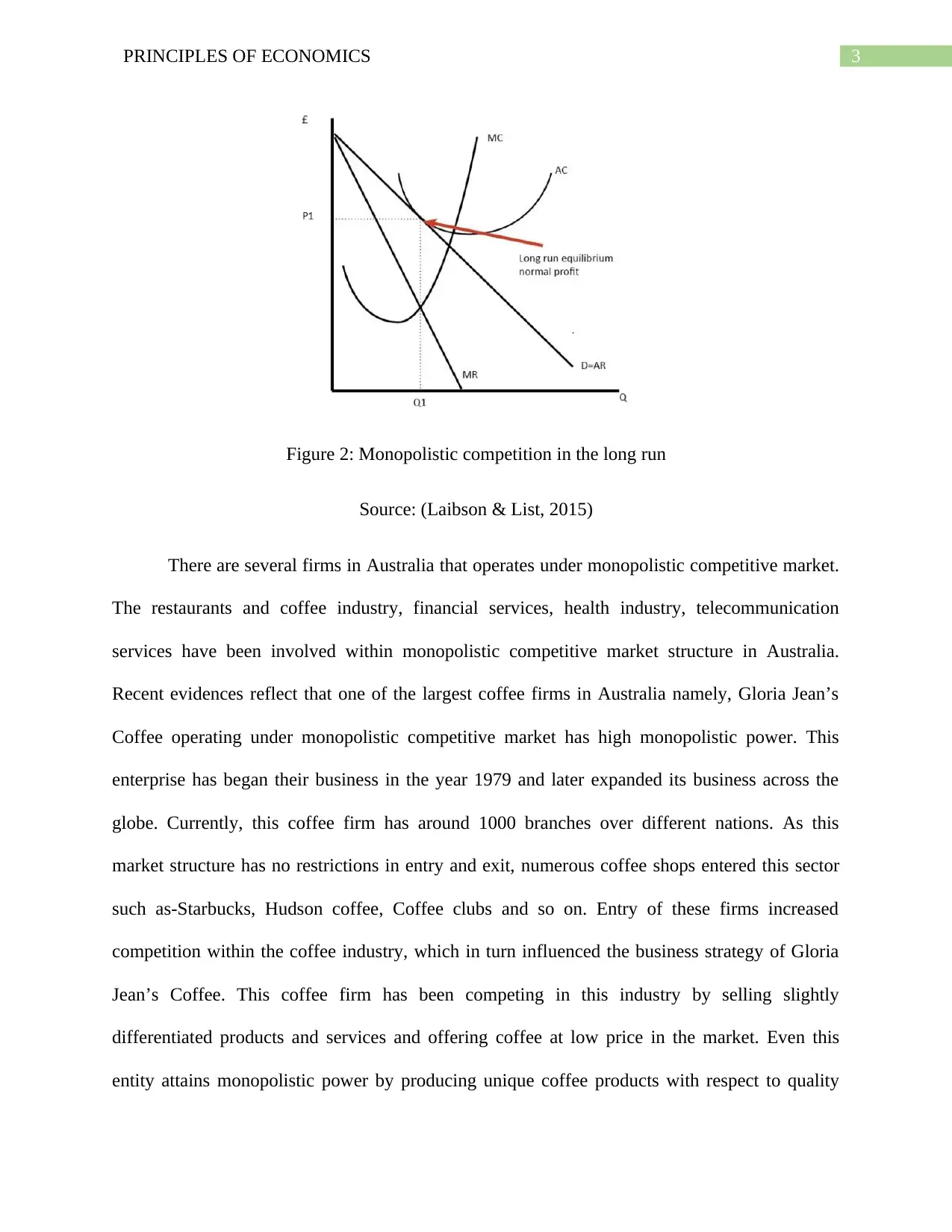
3PRINCIPLES OF ECONOMICS
Figure 2: Monopolistic competition in the long run
Source: (Laibson & List, 2015)
There are several firms in Australia that operates under monopolistic competitive market.
The restaurants and coffee industry, financial services, health industry, telecommunication
services have been involved within monopolistic competitive market structure in Australia.
Recent evidences reflect that one of the largest coffee firms in Australia namely, Gloria Jean’s
Coffee operating under monopolistic competitive market has high monopolistic power. This
enterprise has began their business in the year 1979 and later expanded its business across the
globe. Currently, this coffee firm has around 1000 branches over different nations. As this
market structure has no restrictions in entry and exit, numerous coffee shops entered this sector
such as-Starbucks, Hudson coffee, Coffee clubs and so on. Entry of these firms increased
competition within the coffee industry, which in turn influenced the business strategy of Gloria
Jean’s Coffee. This coffee firm has been competing in this industry by selling slightly
differentiated products and services and offering coffee at low price in the market. Even this
entity attains monopolistic power by producing unique coffee products with respect to quality
Figure 2: Monopolistic competition in the long run
Source: (Laibson & List, 2015)
There are several firms in Australia that operates under monopolistic competitive market.
The restaurants and coffee industry, financial services, health industry, telecommunication
services have been involved within monopolistic competitive market structure in Australia.
Recent evidences reflect that one of the largest coffee firms in Australia namely, Gloria Jean’s
Coffee operating under monopolistic competitive market has high monopolistic power. This
enterprise has began their business in the year 1979 and later expanded its business across the
globe. Currently, this coffee firm has around 1000 branches over different nations. As this
market structure has no restrictions in entry and exit, numerous coffee shops entered this sector
such as-Starbucks, Hudson coffee, Coffee clubs and so on. Entry of these firms increased
competition within the coffee industry, which in turn influenced the business strategy of Gloria
Jean’s Coffee. This coffee firm has been competing in this industry by selling slightly
differentiated products and services and offering coffee at low price in the market. Even this
entity attains monopolistic power by producing unique coffee products with respect to quality
Secure Best Marks with AI Grader
Need help grading? Try our AI Grader for instant feedback on your assignments.
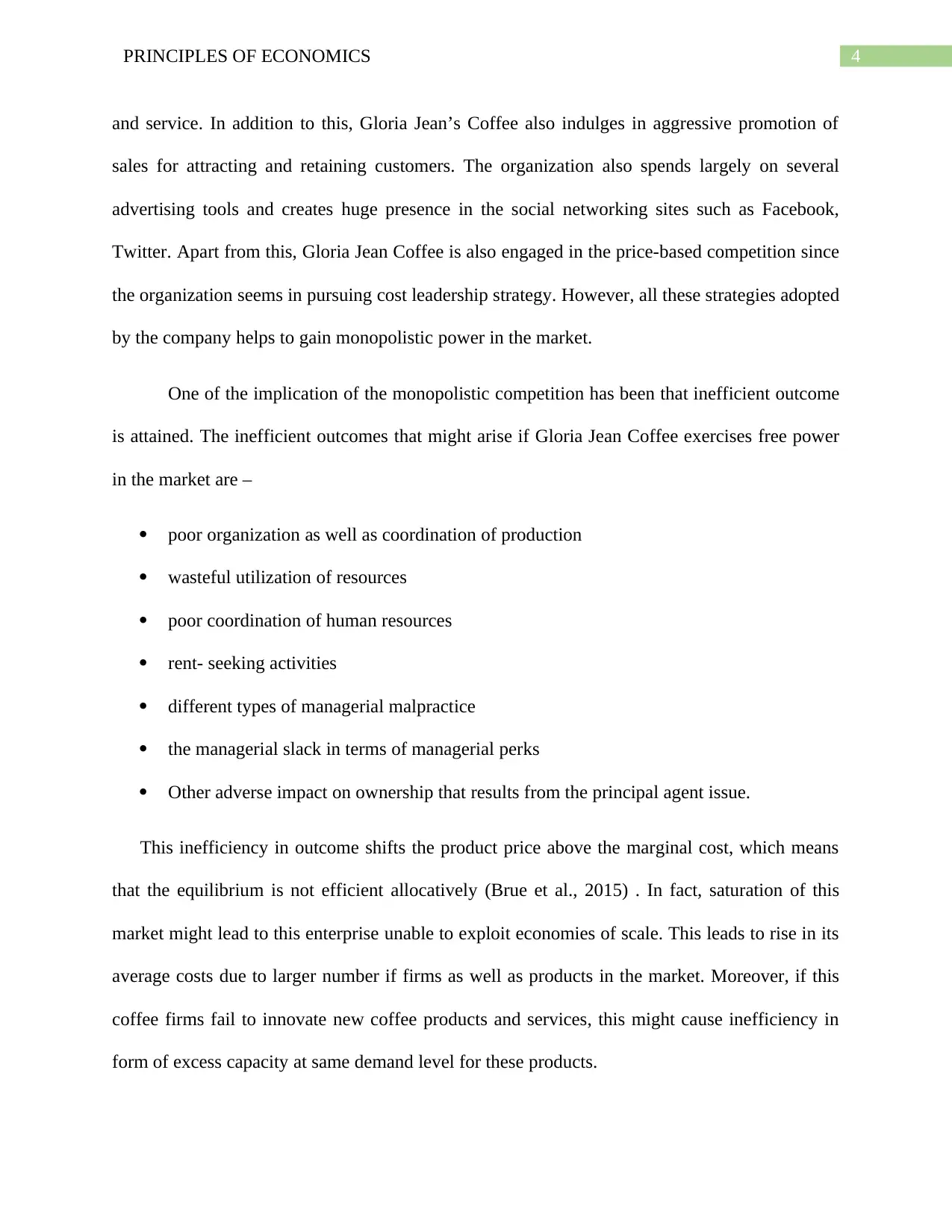
4PRINCIPLES OF ECONOMICS
and service. In addition to this, Gloria Jean’s Coffee also indulges in aggressive promotion of
sales for attracting and retaining customers. The organization also spends largely on several
advertising tools and creates huge presence in the social networking sites such as Facebook,
Twitter. Apart from this, Gloria Jean Coffee is also engaged in the price-based competition since
the organization seems in pursuing cost leadership strategy. However, all these strategies adopted
by the company helps to gain monopolistic power in the market.
One of the implication of the monopolistic competition has been that inefficient outcome
is attained. The inefficient outcomes that might arise if Gloria Jean Coffee exercises free power
in the market are –
poor organization as well as coordination of production
wasteful utilization of resources
poor coordination of human resources
rent- seeking activities
different types of managerial malpractice
the managerial slack in terms of managerial perks
Other adverse impact on ownership that results from the principal agent issue.
This inefficiency in outcome shifts the product price above the marginal cost, which means
that the equilibrium is not efficient allocatively (Brue et al., 2015) . In fact, saturation of this
market might lead to this enterprise unable to exploit economies of scale. This leads to rise in its
average costs due to larger number if firms as well as products in the market. Moreover, if this
coffee firms fail to innovate new coffee products and services, this might cause inefficiency in
form of excess capacity at same demand level for these products.
and service. In addition to this, Gloria Jean’s Coffee also indulges in aggressive promotion of
sales for attracting and retaining customers. The organization also spends largely on several
advertising tools and creates huge presence in the social networking sites such as Facebook,
Twitter. Apart from this, Gloria Jean Coffee is also engaged in the price-based competition since
the organization seems in pursuing cost leadership strategy. However, all these strategies adopted
by the company helps to gain monopolistic power in the market.
One of the implication of the monopolistic competition has been that inefficient outcome
is attained. The inefficient outcomes that might arise if Gloria Jean Coffee exercises free power
in the market are –
poor organization as well as coordination of production
wasteful utilization of resources
poor coordination of human resources
rent- seeking activities
different types of managerial malpractice
the managerial slack in terms of managerial perks
Other adverse impact on ownership that results from the principal agent issue.
This inefficiency in outcome shifts the product price above the marginal cost, which means
that the equilibrium is not efficient allocatively (Brue et al., 2015) . In fact, saturation of this
market might lead to this enterprise unable to exploit economies of scale. This leads to rise in its
average costs due to larger number if firms as well as products in the market. Moreover, if this
coffee firms fail to innovate new coffee products and services, this might cause inefficiency in
form of excess capacity at same demand level for these products.
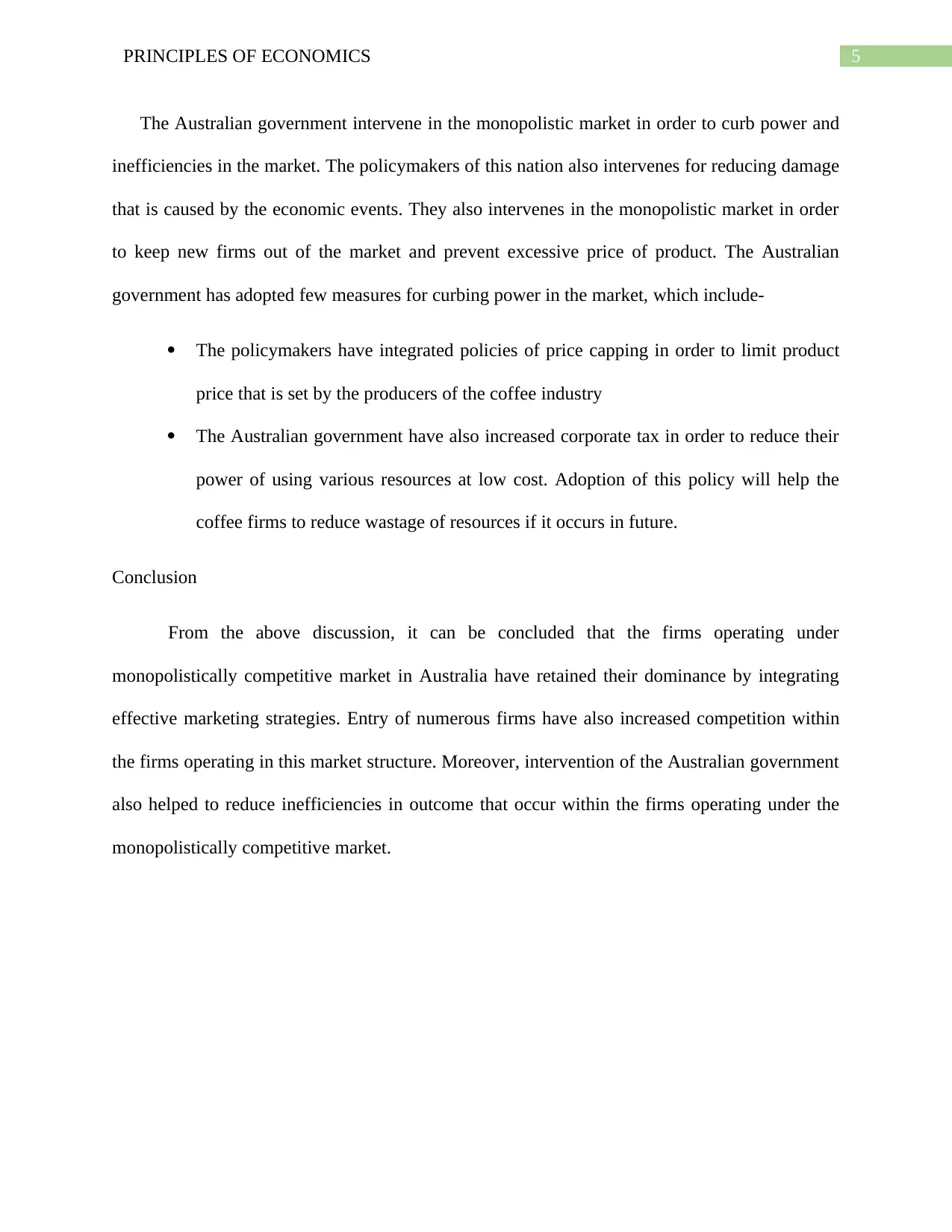
5PRINCIPLES OF ECONOMICS
The Australian government intervene in the monopolistic market in order to curb power and
inefficiencies in the market. The policymakers of this nation also intervenes for reducing damage
that is caused by the economic events. They also intervenes in the monopolistic market in order
to keep new firms out of the market and prevent excessive price of product. The Australian
government has adopted few measures for curbing power in the market, which include-
The policymakers have integrated policies of price capping in order to limit product
price that is set by the producers of the coffee industry
The Australian government have also increased corporate tax in order to reduce their
power of using various resources at low cost. Adoption of this policy will help the
coffee firms to reduce wastage of resources if it occurs in future.
Conclusion
From the above discussion, it can be concluded that the firms operating under
monopolistically competitive market in Australia have retained their dominance by integrating
effective marketing strategies. Entry of numerous firms have also increased competition within
the firms operating in this market structure. Moreover, intervention of the Australian government
also helped to reduce inefficiencies in outcome that occur within the firms operating under the
monopolistically competitive market.
The Australian government intervene in the monopolistic market in order to curb power and
inefficiencies in the market. The policymakers of this nation also intervenes for reducing damage
that is caused by the economic events. They also intervenes in the monopolistic market in order
to keep new firms out of the market and prevent excessive price of product. The Australian
government has adopted few measures for curbing power in the market, which include-
The policymakers have integrated policies of price capping in order to limit product
price that is set by the producers of the coffee industry
The Australian government have also increased corporate tax in order to reduce their
power of using various resources at low cost. Adoption of this policy will help the
coffee firms to reduce wastage of resources if it occurs in future.
Conclusion
From the above discussion, it can be concluded that the firms operating under
monopolistically competitive market in Australia have retained their dominance by integrating
effective marketing strategies. Entry of numerous firms have also increased competition within
the firms operating in this market structure. Moreover, intervention of the Australian government
also helped to reduce inefficiencies in outcome that occur within the firms operating under the
monopolistically competitive market.
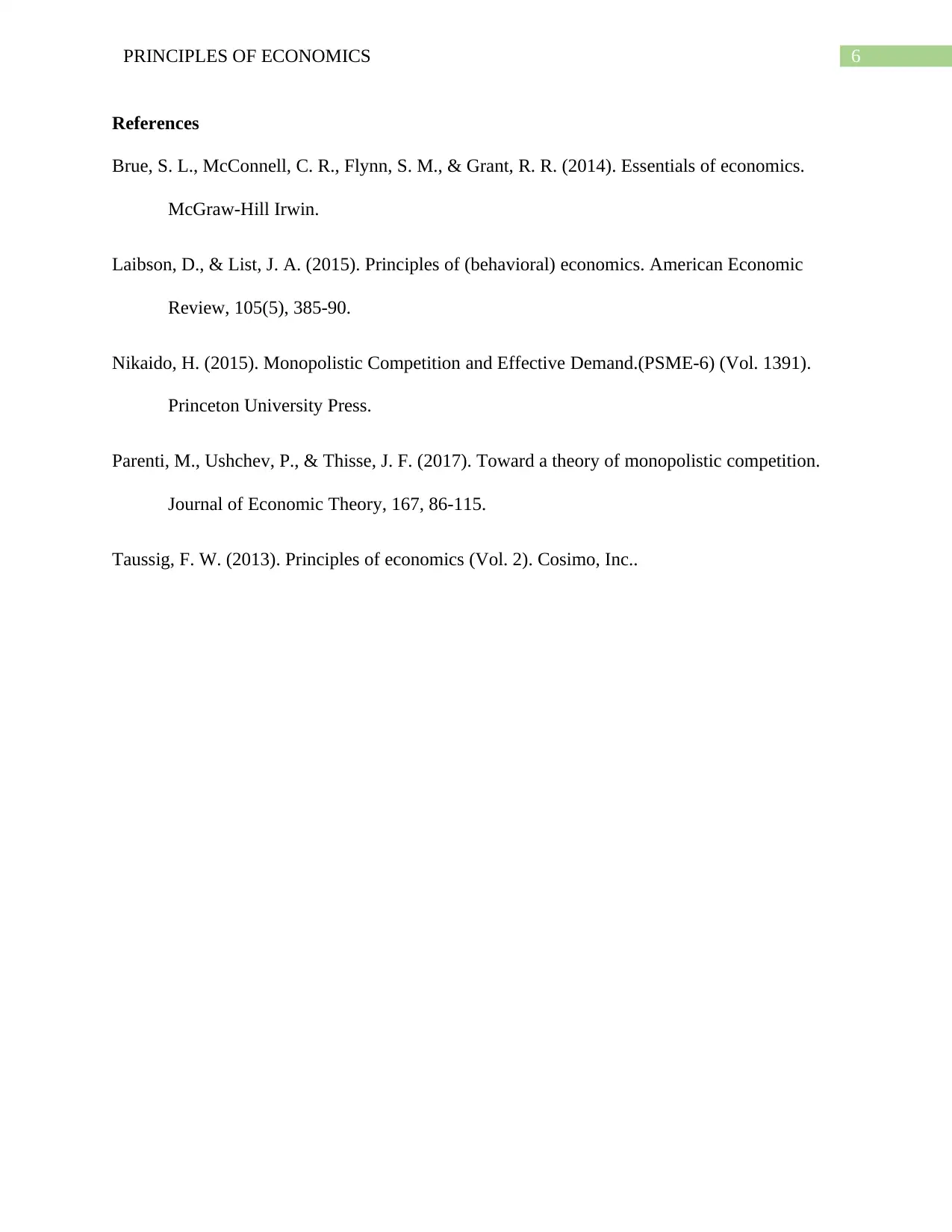
6PRINCIPLES OF ECONOMICS
References
Brue, S. L., McConnell, C. R., Flynn, S. M., & Grant, R. R. (2014). Essentials of economics.
McGraw-Hill Irwin.
Laibson, D., & List, J. A. (2015). Principles of (behavioral) economics. American Economic
Review, 105(5), 385-90.
Nikaido, H. (2015). Monopolistic Competition and Effective Demand.(PSME-6) (Vol. 1391).
Princeton University Press.
Parenti, M., Ushchev, P., & Thisse, J. F. (2017). Toward a theory of monopolistic competition.
Journal of Economic Theory, 167, 86-115.
Taussig, F. W. (2013). Principles of economics (Vol. 2). Cosimo, Inc..
References
Brue, S. L., McConnell, C. R., Flynn, S. M., & Grant, R. R. (2014). Essentials of economics.
McGraw-Hill Irwin.
Laibson, D., & List, J. A. (2015). Principles of (behavioral) economics. American Economic
Review, 105(5), 385-90.
Nikaido, H. (2015). Monopolistic Competition and Effective Demand.(PSME-6) (Vol. 1391).
Princeton University Press.
Parenti, M., Ushchev, P., & Thisse, J. F. (2017). Toward a theory of monopolistic competition.
Journal of Economic Theory, 167, 86-115.
Taussig, F. W. (2013). Principles of economics (Vol. 2). Cosimo, Inc..
1 out of 7
Related Documents
Your All-in-One AI-Powered Toolkit for Academic Success.
+13062052269
info@desklib.com
Available 24*7 on WhatsApp / Email
![[object Object]](/_next/static/media/star-bottom.7253800d.svg)
Unlock your academic potential
© 2024 | Zucol Services PVT LTD | All rights reserved.



